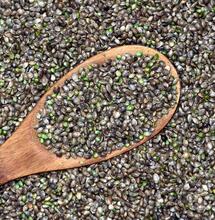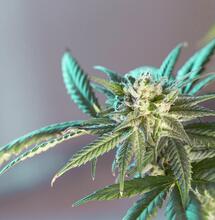Grow Diary: Swazi
_35.jpg)
For this grow I went with Swazi. Originating in Swaziland, South Africa, it's a pure sativa that can reach heights of 6′ 7″ to 9′ 9″, with an exotic taste and smell.
The flowers tend to have large bracts that are resin-coated, and it has a flowering period of nine to fourteen weeks – with high yields. A cutting was taken from a mother plant, applied with Clonex and allowed to propagate until it was brimming with roots.
It was placed on an Atami Wilma four-pot, but the four 11-liter pots were replaced with a single, Mapito-filled 18-liter pot to accommodate one plant and greater root growth. I am a great believer in providing the proper quantity and quality of light, but with this grow I was interested in seeing just what was possible to achieve with this one plant and single 400-watt HID.
On the nutrient front, this time I went for the Atami B'Cuzz Hydro range with Bloom Stimulant and Bloombastic. I also used the additive Vitalink Biopac during the veg stage to ensure a healthy root zone, and the provision of beneficial bacteria. I believe that observation and awareness are the keys to a quality crop, not just checking the pH and EC, but looking – gaining knowledge about your plants.
Having said that, of course the pH and EC were regularly checked, but neither required much alteration during the entire grow. The minimum and maximum temperature and humidity levels were also measured to ensure that there were no major swings that could cause difficulties detrimental to the growth of the plant. Pleasingly, there were no pest problems, either.
The Mapito was thoroughly soaked prior to use, in order to lower its EC value. The cutting was placed in a four-foot (1.2 m) tent that had been lined with diamond reflective material. After the first few weeks of vegetative growth, a plastic mesh was fitted across the tent at a height of about 18 inches above the pot top, and molded into a concave shape to ensure that growth not directly beneath the light was pushed closer to it, for more exposure.
Throughout the veg cycle and for the first week of flowering, any new growth was woven through the mesh, being careful not to cause damage to the delicate shoots and meristems (although if they are given time, plants do normally tend to recover from the occasional snapped stem and they can actually be mended by fixing the two ends of the stem back together with sticky tape).
This method is a form of trellising and helps with light exposure, especially when using a lower-powered light, and is also a method worth considering when dealing with a low ceiling height. The plant was trained to grow horizontally, and a vegetative state was maintained until the majority of the mesh was utilized. Let's face it – veg is everything to good flowering. Vigorous growth was observed through this period of around ten days, as the plant filled out across the mesh.
Throughout the grow, leaves were removed from below the line of the mesh to prevent them from wasting energy by stretching in a search for light. Other leaves were periodically pruned from the canopy, but never more than twenty-five to thirty percent of the large leaves; after all, these are the sites that produce the sugars for growth and flowering. From experience, I have realized that it pays to put the plant into flower when there is still some area of mesh available. This takes into account the growth during the early flowering phase, when the plant makes some room for the buds to grow.
Once this point was reached, I started using the B'Cuzz Bloom stimulant, slowly increasing the dose over the flowering period from half a milliliter to one milliliter. At this time, I also reduced the light cycle from the 18.5 hours the plant had been receiving down to 11.5 hours, to induce flowering.
I used a Sunmaster dual-spectrum bulb with its (thirty percent more) blue spectrum for the vegetative growth and the initial couple of weeks of flowering; then I changed to a Grolux bulb, to give more of the red light spectrum for the final weeks toward harvest. It was not long before there was an observable response from the plant, as flowers began to form across the mesh.
As mentioned earlier, I also introduced Bloombastic into the mix as a bloom booster for the last four weeks, or ripening phase, of flowering. With this product it is advisable to steer away from also using a PK booster. There is no need, as Bloombastic has enough bio-minerals and bio-stimulators contained within it (and I have heard tales of plants being killed when using both together). There was soon a visible increase in the formation of trichomes across the leaves and calyxes.
The plant was put into flush for just under two weeks and was provided with only water to ensure the dissipation of any excess nutrient salts. Then the day of harvest finally came; by this point one got the impression that the mesh was beginning to strain from the weight resting upon it.
When cutting, most of the bud was found above the mesh (one of the benefits of this technique) but there was also a very charming crown of frosted buds, profuse with crystals, that was located just below the mesh. When dried, the yield came in at just under 14.5 ounces of sticky, sweet Swazi bud – a very satisfying and smashing harvest.
Sadly and illogically, it is still illegal in most parts of the world to cultivate any Cannabis without a license. If you want to decrease the danger but heighten the delight, then perhaps you might want to consider 'branching out' and trying this trellising technique.



